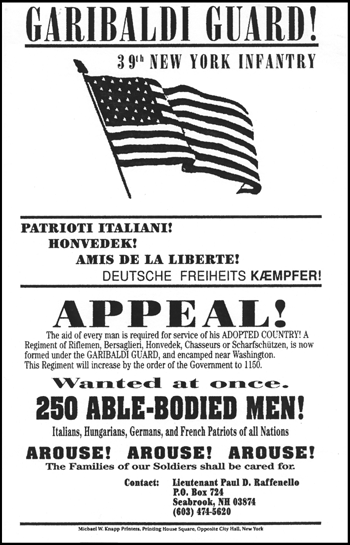
The "Garibaldi Guards"
Combined Companies, New England Chapter, PO Box 724, Seabrook, NH 03874 (603).474.5620
 |
| 39th New York Volunteer Infantry The "Garibaldi Guards" Combined Companies, New England Chapter, PO Box 724, Seabrook, NH 03874 (603).474.5620 |
A Brief History of the 39th NYVI
| New York City in 1861 was as it is today a great melting pot
of people from all over Europe. When the Civil War broke out, many former
"Garibaldini" wanted to give their military talents and lives if need be, to
their adopted country of the United States. Many had followed the great Italian patriot, Guiseppe Garibaldi, in his campaigns in South America and in Italy.
By the 1860s , Garibaldi's name was as well known in America as it was in Europe, and it
was synonymous with the struggle for equality of the common man. The 39th started as an all Italian regiment, but after only two small companies were formed it was decided to join with other ethnic companies already formed. The make up of the guards was truly multiethnic. It had one company each of, Italians, French, French Canadians, Spanish, Portuguese, Swiss, three companies of Germans, and three companies of Hungarians. Also included in these companies were Americans, Irish, South Americans, and several Blacks. As was the tradition with European regiments, there were several "Vivandieres" (female "water carriers") also known as "Cantini6re Girls" who tended the wounded. Unique aspects of the Garibaldi Guards included the fact that it was one of the first three year regiments. They wore distinctive Italian Bersaglieri (Sharpshooter) uniforms, and had several Freed-Negro riflemen in the ranks. Some of the battles they were involved in were First Bull Run, Cross Keys, Defense of Harper's Ferry, Gettysburg, Wilderness, Spottsylvania, Cold Harbor, Saylor's Creek, and Appomattox Court House. The goal of recreating the Garibaldi Guards is to honor the name of Guiseppe Garibaldi, and those men and woman who served and in some cases gave their lives to their adopted country. Join our members in learning of our forefathers ethnic past, and help teach others the contribution European immigrants made during the great struggle called "The American Civil War". |
 |
Giuseppe Garibaldi (1807-1882)
When Garibaldi was born there was no Italy, only a group of small backward states. These
states had long been under foreign domination. Garibaldi was one of the three great
patriots who freed the Italians from foreign rule and unified the country. Giuseppe
Mazzini inspired the people to demand liberation. Count Cavour organized the new state.
Garibaldi was the daring military leader, one of the greatest masters of revolutionary
war.
Giuseppe Garibaldi was born at Nice on July 4, 1807. His father was a fisherman. The
boy wanted a life of adventure and he went to sea. He was in the Black Sea when he joined
Young Italy, a secret society of young men formed by Mazzini. The purpose of the society
was to drive Austria from Italy and unify the peninsula.
In 1834 Garibaldi plotted to seize the frigate on which he was sailing in order to help in
the freeing of Genoa. The plot was discovered, but he escaped to Marseilles, before he was
condemned to death. Finally he made his way to South America. There he took part in wars,
first in Brazil, and then in Uruguay, where he raised and commanded the Italian Legion.
In 1848 there was revolution and insurrection throughout the Italian peninsula. Garibaldi returned, a master of guerrilla warfare, and was hailed as the "hero of Montevideo." He raised volunteers and was given command of the forces of the shortlived Roman Republic, which Mazzini had set up. After a desperate defense he was forced to flee with his followers across the peninsula, pursued by the Austrians. His wife, Anita, who was as daring as he, died and was buried in the sand on the Adriatic coast. Once more Garibaldi became an exile. For a time he worked as a candlemaker on Staten Island, New York.
Returning to Italy in 1854, Garibaldi bought part of the small island of Caprera and settled down to farm. In 1859, war broke out anew with Austria. After fighting in the Alps, Garibaldi decided to aid the Sicilians, who had revolted against their king, Francis 11 of Naples. In May 1860 his "thousand red shirts," on two small steamers, reached the island. City after city fell to him and he took Sicily in the name of Victor Emmanuel II.
This victory aroused all Italy. Thousands of volunteers hastened to join Garibaldi's army. In August he crossed to the mainland to march on Naples. Enthusiastic crowds cheered him wildly. When he entered the city they sang the popular national anthem, now called "Garibaldi's Hymn". After turning over the city to Victor Emmanuel II, Garibaldi bade farewell to his followers and returned to his humble life on Caprera. On February 18, 1861, the kingdom of Italy was proclaimed.
The great need of the new kingdom was peace. Garibaldi, however, was determined to seize Rome, which was still under the rule of the pope. This would have brought both France and Austria against Italy. Twice the Italian government was forced to take Garibaldi prisoner. When finally Italian troops did enter Rome, in 1870, he had no part in the triumph. In that year, he was helping the French Republic against Germany in the Franco-Prussian War.
When the Franco-Prussian War was over, Garibaldi retired once more, on a generous pension, to Caprera. There he spent the rest of his life, receiving admiring visitors and attempting to stir up the people to establish a republic in Italy. He was easily worked upon by unscrupulous agitators who sought the overthrow of the monarchy he had helped to establish. Fortunately the plots did not succeed.
Return to the main Société d'Europe page
Links to web sites related to this topic: